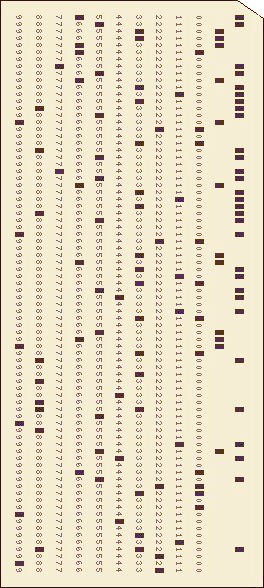Section 3.4 Bits
A bit (short for “BInary digiT”) is a single on/off value. Only these two values are possible, though the two values may go by different names, such as true/false, or 1/0. There are many ways in which a bit can be implemented. Here are some ways that bits are implemented:
-
A mechanical electrical switch (like a light switch.)
-
Voltage on a wire.
-
A light bulb being on or off.
-
The state of a single transistor.
-
The magnetic charge on a tiny part of the surface of a disk.
-
The presence or absence of a hole punched in a card.
-
A tiny part of the light-reflecting surface of a CD.
-
Part of a radio signal.

Each hole (or spot where there is no hole punched) in this card represents a bit of information.
Computers do all of their processing in terms of bits - any piece of information a computer stores or manipulates is stored as a sequence of these on/off values. For different purposes, a computer may use any of the mechanisms listed above (or many others) to represent those bits.
Checkpoint 3.4.2.
Which one of the following statements is FALSE?
- The method used to implement a bit does not affect the information it represents
- A light bulb that is "Off" represents the same thing as an "Off" represented by a hole that is not punched
- A bit may be implemented as a small part of a magnetic disk.
- This is how hard drives store information
- Copying a bit from one medium to another does not affect the information it represents.
- Computers do this all the time - turn an electrical signal in a circuit into a magnetic field on a disk. Or turn a hole into a punch card into an electrical signal
- A bit is always implemented as something electrical.
Remark 3.4.3.
Introduction to Computer Science using JavaCC BY-SA 3.0You have attempted of activities on this page.
